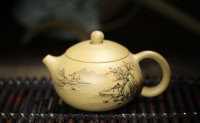
Yixing zisha(purple clay)is the materials of yixing clay teapot, the umbrella term for all raw clay materials found in Yixing,China.They have been used as materials for teapots for more than 500 years.The teapot made of this material is called a "breathing" teapot because of its special material, good air permeability and can make the tea more fragrant. The Main Categories of Zi sha The names for each type of Zisha have unique origins.Most of the names come from the color of the clay after firing.These include some of the main categories of Zisha, like Zi ni (purple clay), Hong ni (red clay), and Zhu ni (vermillion clay).An exception to this is Lv ni (green clay), which refers to the color of the raw material.Duan ni (mixture of different kinds of Zi sha).
1.Zi ni (purple clay)
Zi ni is the most popular and the most common of all Zisha.It is the original clay which gave Yixing clay teapot its fame, 500 years ago.based on their composition, location from which they were mined, and the depth they were mined from,zisha has more than 20 knids of variants,Some of the famous variants of Dicaoqing and Tianqing ni. Zi ni has good plasticity, high strength, low shrinkage during firing, and generally good performance through the whole process of making a teapot.Furthermore, because of Zini's porous structure, it could greatly improve the taste of the low-quality tea the common people drank in those times The color of the finished Zini teapot is usually composed of various shades of brown and purple.
2.Hong ni(Red Clay)
Hong ni is a Zisha material named for the color of the clay after firing.It is a general category that can be divided into two subcategories, according to the raw materials used: "Hongni" and "Zhuni",Some of the famous variants of Hongni are Dahongni,Dahongpao , Xiaohongni, Hongpilong and Jiangponi. Hongni, in its raw form, has a reddish or yellow color with a relatively uniform texture.It's quite dense but easy to break up.Unlike Zhuni, it is not water-soluble.Hongni has a similar performance to Zini during the forming and firing process.When made into a teapot, it has structural properties and general characteristics similar to Zini, but it is slightly less porous.The color of the finished teapot is orange, or shades of red.
3.Zhu ni (Vermillion Clay)
Zhuni is yellow in its raw form, and has a chalk-like texture.Unlike all other Zisha, Zhuni is water-soluble.Its shrinkage rate can be significant, and its plasticity is comparatively low.For these reasons, Zhuni is extremely difficult to work with, therefore in the past, only the greatest masters of Yixing were able to make pure Zhuni teapots, mostly they blended the clay with other Zisha, like Baini or Duanni. The finished Zhuni teapot has a very dense structure, and is therefore the least porous of all Zisha, almost like porcelain in nature.The color of the teapot after firing spans a range of reds: brownish, bright, orange and dark.
4.Lv ni (green clay)
Lvni is the rarest of the common Zisha categories.Only around 2% of all Zisha is Lvni.It is named after the color of the raw ore. Lvni needs to be high fired, otherwise, it can "spit black" or crack from usage.Lvni has the best air permeability and heat preservation of all Zisha.However, these properties can vary according to where the material was mined, and the depth from which it was mined. After firing it usually has a kind of pastel yellow, satin, beige coloration.
5 Duan ni (Group Clay)
Duanni is not a single type of Zisha, but a mixture of the others.Usually, it is a mixture of Zini and Lvni, or Lvni and Hongni.Because of this, Duanni can be anything.It's the most diverse and complex of Zisha, and can have the attributes of Zini, Lvni, Hongni in any proportion.The color of the finished teapot can be anything in the range of and between the other Zisha types.
If you want to avoid buying a teapot made of inferior chemical materials, please refer to here.











Leave a Reply Cancel Reply